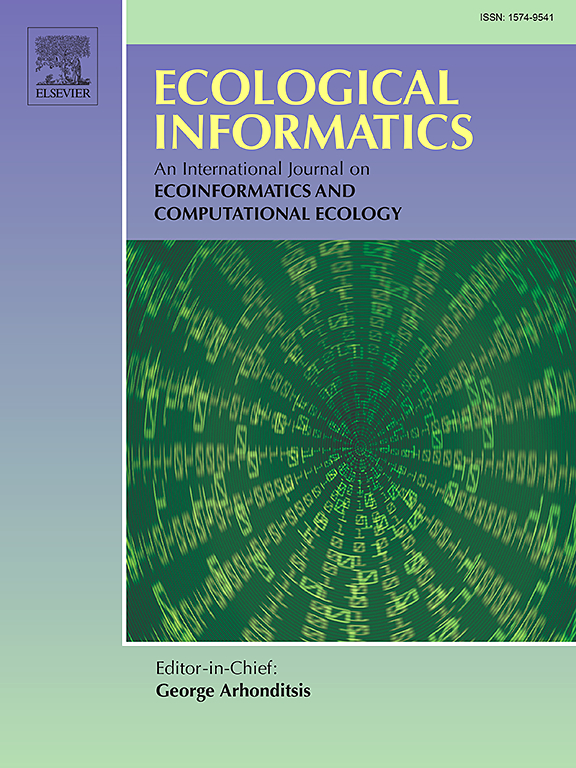Enhancing coastal bathymetric mapping with physics-informed recurrent neural networks synergizing Gaofen satellite imagery and ICESat-2 lidar data: A case in the South China Sea
IF 5.8
2区 环境科学与生态学
Q1 ECOLOGY
引用次数: 0
Abstract
Satellite-derived bathymetry (SDB) has emerged as a critical technique in response to the growing demand for large-scale coastal bathymetric mapping. However, high-resolution multispectral imagery from Gaofen satellites presents significant challenges owing to low signal-to-noise ratios (SNRs). This study aimed to enhance coastal bathymetric mapping by integrating high-resolution Gaofen satellite imagery with ICESat-2 lidar-derived bathymetry. The specific goals are to develop a novel physics-informed recurrent neural network (PI-RNN) for SDB that does not rely on prior information and assess its performance in terms of accuracy and robustness. We propose a physics-based RNN model that combines spectral and radiative transfer information from Gaofen satellite imagery with reference bathymetric data from ICESat-2. This methodology includes an adaptive ellipse density-based spatial clustering of applications with noise (AE-DBSCAN) algorithm for ICESat-2 data extraction, which surpasses standard DBSCAN in terms of accuracy. The RNN model was trained using various band combinations of Gaofen satellite data, and its performance was evaluated against in-situ measurements from Ganquan Island in the South China Sea. The physics-based RNN model achieved good bathymetric accuracy, with a coefficient of determination (R2) value >0.93 and a root mean square error (RMSE) < 0.83 m when compared to in-situ measurements on Ganquan Island, indicating the model demonstrates high robustness even under low-SNR satellite imagery conditions. In addition, the inclusion of radiative transfer information in the band combination significantly improved the training accuracy of the model, with the average RMSE being 0.2 m lower and the average R2 improving by 3 % compared to results without physical information. On Huaguang Reef, the model performance further improved with R2 values ranging from 0.93 to 0.97 and RMSE between 0.55 and 0.66 m after applying atmospheric correction when compared to the ICESat-2 reference bathymetric data. Without atmospheric correction, the R2 of the estimated depth was in the range of 0.85 to 0.94 and RMSE in the range of 0.62 to 0.71 m, indicating that although the model mitigated some atmospheric interference effects, atmospheric correction was still necessary to achieve higher accuracy under strong atmospheric conditions. This study demonstrates that a PI-RNN can significantly enhance SDB accuracy, even under challenging conditions. The integration of active and passive remote-sensing data provides a reliable and efficient tool for large-scale coastal bathymetric mapping. The unique contribution of this study lies in the development of a novel RNN model that leverages both spectral and physical information, offering a more accurate and generalised approach to SDB.
Plain language summary
Traditional methods for creating these maps are limited because of their high cost, time consumption, and reliance on favourable weather and sea conditions. To overcome these challenges, we integrated high-resolution images from China's Gaofen satellite with precise laser measurements obtained from NASA's ICESat-2 satellite. Using a physics-based recurrent neural network (RNN), we processed these data and generated detailed bathymetric maps without the need for onsite measurements. The key steps in our process included developing a new algorithm to extract accurate seafloor data from ICESat-2 laser measurements, and a neural network that incorporated both spectral information from satellite images and the physical principles of light interaction in water bodies. We tested our method in the South China Sea, where it produced highly accurate results with a coefficient of variation (R2) value >0.93 and a root mean square error (RMSE) < 0.83 m when compared to actual measurements from an island in the area. This study demonstrates that our method not only achieves remarkable bathymetric accuracy but also simplifies the mapping process by eliminating the need for complex atmospheric corrections. This advancement is a significant step forwards in the field of coastal mapping and offers a more efficient and effective tool for managing and understanding coastal resources and the environment.
利用物理信息递归神经网络协同高分卫星图像和ICESat-2激光雷达数据增强沿海水深测绘:以中国南海为例
卫星衍生测深技术(SDB)已成为应对大规模沿海测深测绘日益增长需求的一项关键技术。然而,由于低信噪比(SNRs),高分卫星的高分辨率多光谱图像面临着重大挑战。本研究旨在通过将高分辨率高分卫星图像与ICESat-2激光雷达衍生的测深技术相结合,增强沿海测深制图。具体目标是为SDB开发一种不依赖于先验信息的新型物理信息递归神经网络(PI-RNN),并在准确性和鲁棒性方面评估其性能。我们提出了一个基于物理的RNN模型,该模型结合了来自高分卫星图像的光谱和辐射传输信息以及来自ICESat-2的参考水深数据。该方法包括用于ICESat-2数据提取的基于自适应椭圆密度的带噪声应用空间聚类(AE-DBSCAN)算法,其精度优于标准DBSCAN。利用高分卫星数据的不同波段组合对RNN模型进行训练,并根据南海甘泉岛的现场测量结果对其性能进行了评估。基于物理的RNN模型获得了良好的测深精度,其决定系数(R2)值为0.93,均方根误差(RMSE)为0.93;与甘泉岛的原位测量值相比,误差为0.83 m,表明该模型即使在低信噪比的卫星图像条件下也具有较高的鲁棒性。此外,在波段组合中加入辐射传输信息显著提高了模型的训练精度,平均RMSE比没有物理信息的结果降低了0.2 m,平均R2提高了3%。与ICESat-2参考水深资料相比,在华光礁进行大气校正后,模型性能进一步提高,R2值在0.93 ~ 0.97之间,RMSE在0.55 ~ 0.66 m之间。在没有大气校正的情况下,估算深度的R2在0.85 ~ 0.94之间,RMSE在0.62 ~ 0.71 m之间,说明在强大气条件下,虽然模式减轻了一些大气干扰效应,但仍需要大气校正以达到更高的精度。该研究表明,即使在具有挑战性的条件下,PI-RNN也可以显著提高SDB的准确性。主动和被动遥感数据的整合为大规模海岸测深测绘提供了可靠和高效的工具。这项研究的独特贡献在于开发了一种新的RNN模型,该模型利用了光谱和物理信息,为SDB提供了更准确和更通用的方法。制作这些地图的传统方法由于成本高、耗时长以及对有利天气和海况的依赖而受到限制。为了克服这些挑战,我们将来自中国高分卫星的高分辨率图像与美国宇航局ICESat-2卫星获得的精确激光测量数据相结合。使用基于物理的循环神经网络(RNN),我们处理了这些数据,并生成了详细的水深图,而无需现场测量。我们的关键步骤包括开发一种新的算法,从ICESat-2激光测量中提取准确的海底数据,以及一个神经网络,该网络结合了卫星图像的光谱信息和水体中光相互作用的物理原理。我们在南中国海测试了我们的方法,在那里它产生了高度精确的结果,变异系数(R2)值>;0.93,均方根误差(RMSE) <;与该地区一个岛屿的实际测量值相比,误差为0.83米。这项研究表明,我们的方法不仅达到了显著的水深精度,而且通过消除复杂的大气校正简化了制图过程。这一进展是沿海制图领域向前迈出的重要一步,为管理和了解沿海资源和环境提供了更有效的工具。
本文章由计算机程序翻译,如有差异,请以英文原文为准。
求助全文
约1分钟内获得全文
求助全文
来源期刊

Ecological Informatics
环境科学-生态学
CiteScore
8.30
自引率
11.80%
发文量
346
审稿时长
46 days
期刊介绍:
The journal Ecological Informatics is devoted to the publication of high quality, peer-reviewed articles on all aspects of computational ecology, data science and biogeography. The scope of the journal takes into account the data-intensive nature of ecology, the growing capacity of information technology to access, harness and leverage complex data as well as the critical need for informing sustainable management in view of global environmental and climate change.
The nature of the journal is interdisciplinary at the crossover between ecology and informatics. It focuses on novel concepts and techniques for image- and genome-based monitoring and interpretation, sensor- and multimedia-based data acquisition, internet-based data archiving and sharing, data assimilation, modelling and prediction of ecological data.
 求助内容:
求助内容: 应助结果提醒方式:
应助结果提醒方式:


